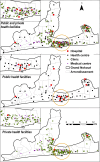Modeling Geographical Accessibility and Inequalities to Childbirth Services in the Grand Nokoué Metropolitan Area, Benin
- PMID: 40924296
- PMCID: PMC12484443
- DOI: 10.1007/s11524-025-01000-y
Modeling Geographical Accessibility and Inequalities to Childbirth Services in the Grand Nokoué Metropolitan Area, Benin
Abstract
Timely access to comprehensive , high-quality emergency obstetric and neonatal care can prevent maternal and neonatal mortality but remains challenging in Benin. We examine geographic accessibility to childbirth care (CBC) in Grand Nokoué, the largest conurbation in Benin. We gathered data on boundaries, health facilities, road network, elevation, land cover, relative wealth, urbanicity, and geo-traced travel speeds over 45 days during the rainy season. We modelled travel times (TT) to health facility offering CBC (stratified by level and sector) using the least-cost path algorithm, based on slowest, average, and fastest travel speeds. We estimated the percentage of women of childbearing age (WoCBA) within 30, 60, and 120 min of the nearest facility by subnational areas. We explored inequalities in TT by wealth quintile and urbanicity gradient. TT to nearest facility at average speed was 8 min and 24 min at slowest speed. For hospitals, this was 31 and 106 min, respectively. TT ranged from 2 to 38 min across arrondissements at average speeds. At average speeds, all WoCBA lived within 30 min of a health facility and 71.6% of a hospital. At slowest speed, this decreased to 84.7% and 22.9%, respectively, with substantial variations across arrondissements. TT to hospitals at average speed was five-fold longer among women from the poorest (50 min) compared to the richest quintile, while TT was shorter in the core urban (27 min) relative to peri-urban (46 min). TT to CBC varied by wealth and urbanicity gradient and was longer at the slowest speeds. Targeting peri-urban areas and poorest WoCBA with longer TT will reduce inequities.
Keywords: Benin; Grand Nokoué; Inequities; Maternal health; Relative wealth; Spatial accessibility; Travel time; Urban areas.
© 2025. The Author(s).
Conflict of interest statement
Declarations. Ethical Approval: This study used secondary publicly available data and primary data (travel speeds, location of health facilities) which did not require ethical approval.
Figures





References
-
- WHO, UNICEF, UNFPA et al. Trends in maternal mortality 2000 to 2020. Geneva; 2023. Geneva: World Health Organization. Available from https://iris.who.int/bitstream/handle/10665/366225/9789240068759-eng.pdf.... Accessed 4 Jul 2025.
-
- Paxton A, Maine D, Freedman L, et al. The evidence for emergency obstetric care. Int J Gynaecol Obstet. 2005. 10.1016/j.ijgo.2004.11.026. - PubMed
MeSH terms
Grants and funding
LinkOut - more resources
Full Text Sources
Medical

